Jack (Evangelos) Vanges
Jack Vanges was born in Kythera on the 17th January, 1913. He came to Nyngan when only about 16 years old. He worked at the California Cafe for Mr Nicholas Crethar for many years, eventually acquiring ownership of the Cafe himself.
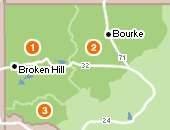
Jack is standing on the right hand side.
Jack applied himself diligently to his business, in which he was very successful, but as the years passed and he was in a position to do so, he took an interest in community affairs. One of his interests was the revival of cycling as a sport in Nyngan, which is described elsewhere.
In 1941, Jack Vanges married Miss Bonnie Coroneos, of Scone, at the Greek Holy Trinity Church, in Sydney, and from then on they worked together. In due course, their daughters, Lillian and Helen, assisted them, particularly in the shoe shop which they established in the premises now occupied by Mr Noel Lennon.
In the early 1960s Jack bought the old Court House Hotel, and having disposed of his Cafe business to the Stathis Brothers, he proceeded to convert the hotel building to flats and offices, which are now known as Vanges Buildings.
It was during this time that Jack Vanges was elected to the Municipal Council. He was Mayor of Nyngan for some years, during which time he did not accept his Mayoral Allowance, directing that it be used for the purchase of trees for planting in the streets, These trees are now a source of delight, an inspiration to the people of town, and a memorial to him.
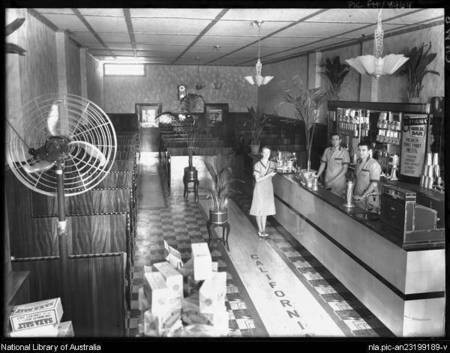
Nyngan Treescape, 2005. A perpetual tribute to Jack Vanges and family.
Jack was also a member of Rotary which he supported with great enthusiasm.
On Saturday, December 18, 1976, Jack and Bonnie, accompanied by Mr Jim Edwards, were driving to Narromine, in the course of another of Jack’s interests, which was bookmaking. The car overturned and Jack’s life was over, as it was also for Jim Edwards. Bonnie lived for several weeks before succumbing to her injuries. [She died on 01 January, 1977].
This tragic accident was a devastating shock for their family and friends. They left a family of three one son, John, now living in Denmark, and two daughters, Lillian and Helen, who live in Sydney. [Lillian died, 04 November, 2000].
In the area near the Railway Station in Nyngan, known as Vanges Park the Bogan Shire Council erected a monument and plaque in memory of Mr and Mrs Jack Vanges.
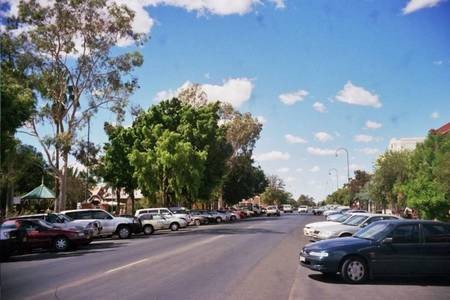
The inscription reads, Vanges Park, In memory of Mr and Mrs E J Vanges. And their untiring work for Nyngan and District.
From a section entitled, Nyngan's Pioneers ,
In:
Nyngan on the Bogan , 1893-1993, with addendum, 1992.
History of Nyngan and Settlement on the Bogan, illustrated.
National Library of Australia card number and ISBN
0-9591 866-0-3
Copyright © Nyngan Historical Society, 1983.
First Edition September 1983
Second Edition November 1983
Reprinted November 1986
Wholly set up and printed in Dubbo, Australia. All rights reserved.
Printed by Macquarie Publications Pty Ltd, 51-59 Wheelers Lane, Dubbo NSW, 2830.
Published by Nyngan Historical Society, 12 Cathundril Street, Nyngan 2825.
This book was published by
Nyngan Historical Society
with assistance from:
The Bogan Shire Council;
Nyngan Apex Club;
Royal Australian Historical Society.
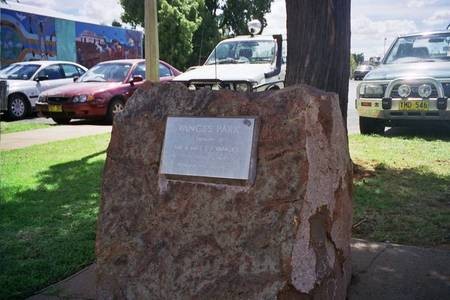
Well appointed Nyngan Museum, incorporating parts of the Railway station. It lies directly opposite the main street. The History of Nyngan, the sign over the entrance proclaims. It houses a number of California Cafe artefacts, including milk shake containers, original signage, and original doors.
Leaving an unduring sporting legacy
Jack Vanges was a "sports fanatic". In his youth, he was an accomplished amateur boxer and cyclist.
Cycling
Bill Barrow, currently (2005), the barber in Nyngan, recalls Jack as a coach and administrator. He laughs at the fact that Jack rarely called any one of his "charges" by their first name - but always had a "nickname" - "parachoukli" for each of them.
Cricket
Jack Vanges left many sporting legacies - including the Jack Vanges trophy for cricket supremacy in the district.
From the Nyngan Observer:
RSL to face Colts in big grand final
Thursday, 17 March 2005
RSL cruised into their second successive grand final on Saturday with a convincing win over Tottenham.
Tottenham were all out in the second last over of their innings to post an average total of 187.
RSL bowled tightly early on and claimed big scorer Greg Radford before he got going.
Tottenham's lower order rejuvenated their innings and some big hitting from P Lees and B Baldwinson made their total respectable.
RSL got off to a flyer in the run chase, Dave Butler played the innings of his career with a quick- fire 48.
Tottenham's bowlers had no answers to the sharp eyes of Peter Lupton and D Butler going at over a run a ball in the first 10 overs.
Lupton fell for 45 and the run rate didn't slow with Peter Rees (41) and Russell George (28) at the crease ticking it over.
RSL passed the score with plenty of overs to spare and six wickets in hand to advance to next weekend's grand final against the Bowling Club Colts.
The Colts who had the weekend off after going straight into the grand final will be chasing their 8th consecutive Jack Vanges trophy and if successful will equal the record set by the Graziers team between 1967/68 and 1974/75.
Nyngan. History
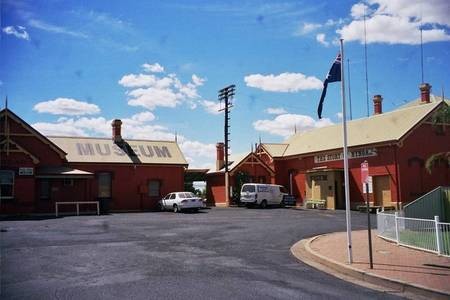
The town of Nyngan (not marked on this map) lies in "öutback" New South Wales, on the junction of the Barrier Highway leading east from Broken Hill, and the Mitchell Highway which runs north-west to Bourke, and south-east to Dubbo. (Beneath the numeral 71).
Nyngan (and Canonba)
Pleasant country town and service centre on the Bogan River
Nyngan is a country town of some 2500 people, situated by the Bogan River on the eastern edge of the Great Outback. It is located on the Mitchell Highway between Narromine and Bourke, 583 km north-west of Sydney and 173 metres above sea-level. The Barrier Highway also starts at Nyngan, heading west to Cobar. Wool, wheat and cattle are the primary local produce in what is a very productive pastoral and agricultural shire.
The district was originally inhabited by the Ngiyambaa Aborigines. Thomas Mitchell explored the Bogan River in 1835, camping on the future townsite. He recorded the local Aboriginal word 'nyingan', said to mean 'long pond of water', though other meanings have been put forward. Squatters had settled in Mitchell's wake before he had even begun the return journey.
The acting botanist with the expedition was Richard Cunningham, the younger brother of noted explorer Allan Cunningham. He was killed by Aborigines 84 km south-east of Nyngan when he got lost after straying from the main party (a cairn marks the spot, near the locality of Tabratong). Apparently Cunningham approached the Aborigines gesticulating that he was hungry. They fed him and he made camp with them but he aroused suspicions in the course of the night when he arose several times so they clubbed him to death while he slept. A cairn has been erected to mark the spot. The police investigated and arrested three men who readily confessed. Two later escaped and a third was taken to Sydney, his fate unknown.
This was not an isolated incident. Relationships with Aborigines on the lower Bogan River were characterised by conflict and, as a result, the government cancelled all pastoral licenses beyond the Derribong run in 1845.
It is said that a massacre occurred in the area in 1842. During a prolonged drought some stockmen employed by William Lee set off from a station 16 km north of Peak Hill in search of water with 1200 cattle in tow. They came across a large waterhole, to the north of present-day Nyngan, where a large number of Aborigines were camped. The whites informed the Aborigines that only those who wished to work could stay and the rest must leave. Not surprisingly, this caused considerable ill-feeling. When one Aborigine shook his fist at the stockmen he was strung up by the wrists and whipped. One of the white men was concerned at the signs of growing resentment and tried to convince the others to leave but, failing in his endeavours, he departed on his own. He looked back later in the day and noted birds of prey hovering over the distant site. He returned and found five badly mutilated bodies and one survivor with severe wounds.
When the deaths were reported a police troop was sent to inflict punishment. It is said three were killed and three arrested but it is believed that hundreds more Aborigines were subsequently killed. Certainly when Thomas Mitchell revisited the area in 1845 he was surprised by the absence of Aborigines when he had estimated a thousand to live along the river during his 1835 expedition. When word of the massacres reached Governor Gipps he cancelled William Lee's squatting license.
The small town of Canonba was the first local settlement of any duration. It was established to the west of the Bogan and 28 km north-west of today's Nyngan. Cobb & Co made it a coach stop on the route north-west to Bourke and to the properties of the far west. Bushranger Charles Rutherford was shot by the owner of the Canonba Inn in 1867 while bailing up the establishment.
Nyngan was gazetted as a reserve for water in 1865 but a townsite was not reserved until 1880. It was surveyed in 1882 when the Dubbo-Bourke railway was under construction. The track arrived in Nyngan the following year, signalling the end of Canonba's existence. Symbolically enough, a number of houses from the older settlement were dismantled and re-erected at Nyngan in 1883.
By this time the initial emphasis on cattle had been balanced by the grazing of merino sheep for their wool. Wheat-growing also began in the 1880s although unreliable rainfall has always been a problem, as the Bogan only flows after rain. The town received a secure water supply in 1942 when water was relayed along a 62-km canal from the Macquarie River.
Nyngan became a municipality in 1891. A meatworks developed on the outskirts of town in the 1890s for the boiling down of sheep and an experimental farm was established in 1910 to further wheat cultivation.
Nyngan, little known in the east, entered the national psyche in 1990 when it was deluged with the worst floods of the century. The townspeople laid 260 000 sandbags on top of the established levee but the waters inundated the entire town, causing $50 million worth of damage and necessitating the airlift by helicopter of 2000 citizens, virtually the entire population. A national relief fund was established to help the town recover.
Today Nyngan's role as a rail centre has terminated with the cancellation of the service to Bourke and it is now a service centre to the surrounding district. The Agricultural Show is held in May.